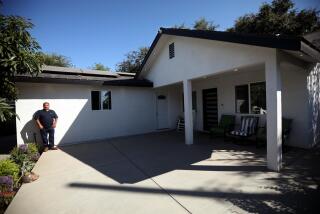Apartment demand drives commercial building rebound
After an extended lull brought on by the economic downturn, commercial real estate developers are building again.
Some of the activity involves the revival of projects that stopped during the recession, but many others are new from the ground up and mark the return of construction cranes to the Southern California skyline along with the injection of billions of dollars into the local economy.
An intense demand for apartments is the biggest driver of development, as the improving economy supports the formation of new households. But offices, warehouses and stores are also being built, according to real estate brokerage Marcus & Millichap.
âWe havenât had any meaningful construction of any type since 2005 or 2006,â said Hessam Nadji, managing director of research at the brokerage. âA new cycle is beginning.â
He expects 6,600 apartments and 2.4 million square feet of commercial space to be delivered this year in Los Angeles County. More is on the way.
âWeâre finally coming out of our bunkers,â Los Angeles developer Wayne Ratkovich said of his fellow builders. âPeople are tired of being down in the dumps and are starting to look for opportunities.â
Ratkovich is renovating aviation mogul Howard Hughesâ former offices in Playa Vista, a development called the Hercules Campus that he expects to cost as much as $90 million. His tenants, including YouTube, are also spending substantial sums to build out their spaces, he said.
One of the regionâs most high-profile developers, Rick Caruso, estimated that he has about $750 million worth of development in the pipeline including what he called a âhugeâ project the size of his popular Grove shopping center in the Fairfax district of Los Angeles.
He declined to elaborate or say where in Southern California he intends to build the new project. One development he expects to finish in September is a $60-million luxury apartment complex on Burton Way at La Cienega Boulevard. The eight-story complex, called 8500, will house 88 apartments over a Trader Joeâs grocery store.
At his Americana at Brand shopping and residential complex in Glendale, Caruso is building a new Nordstrom store and adding four apartments to the developmentâs roster of 100 condominiums and 238 apartments, almost fully occupied.
The developer said he also expects to start work shortly on his long-stalled Miramar Hotel project in Santa Barbara.
âItâs time to break ground,â he said. âWe just paid off the loan and will start development.â
The dilapidated Miramar has been closed for more than a decade. Carusoâs plans call for razing it and building a $170-million hotel with 186 rooms.
Caruso said he would also like his company, Caruso Affiliated, to grow through acquisitions, but that commercial real estate prices have rebounded so much since the recession that itâs hard to realize a substantial financial return from such investments.
âPeople are falling over themselves and making crazy deals,â he said. âItâs as if 2008 never existed.â
Investors have driven up the prices of top-quality buildings in great locations, but land prices are still fairly depressed, Caruso said. Lenders are also game to finance new projects for developers they trust.
âThe opportunity and upside on development is better than itâs ever been, especially [compared] to acquisitions,â he said.
Industrial buildings such as warehouse distribution centers are rising again in the Inland Empire to handle the traffic of merchandise through the ports of L.A. and Long Beach. In Long Beach, a $490-million courthouse is being built in a public-private partnership. Itâs set to open next year.
Numerous older, small industrial buildings on L.A.âs Westside have been converted to offices for creative types. One of the largest office projects coming on line this year is the Red Building, a $165-million, 400,000-square-foot complex in the Pacific Design Center in West Hollywood designed by architect Cesar Pelli.
The darling of Southern California development right now, though, is the apartment building.
Several factors are driving demand, said developer Ziv Cohen, chief operating officer of Resmark Apartment Living, a division of L.A.-based Resmark Cos. People reaching their 20s and 30s, known as Generation Y, tend to marry later than previous generations, he said. They are also more mobile in their careers, which tend to be in urban areas. As the economy recovers, they are leaving their parentsâ homes or jettisoning roommates and setting up households of their own.
Some older renters deliberately downsized from houses, while others became renters by necessity when they couldnât keep up the mortgage payments on their homes or were priced out of the market, Cohen said.
Resmark has invested in or is committed to investing in more than $300 million worth of apartments in the West including the Avenue, a 180-unit complex that opened in January in Hollywood. His company will also build 160 units as part of the Village at Santa Monica being constructed on Ocean Avenue.
Developers are being spurred to build by âhistorically low building costs,â including rock-bottom interest rates, Cohen said.
The trend of declining homeownership will eventually reverse, he predicted.
âWe believe the window of opportunity on apartment development will be open over the next 24 months,â he said.
Marcus & Millichapâs Nadji agreed that the apartment development boom has a ways to go.
âThe supply that has been added so far is going to fall short of demand,â he said. âRental demand is going to continue to increase as jobs come back, and people remain wary of buying homes or are unable to qualify to buy a home.â
More to Read
Inside the business of entertainment
The Wide Shot brings you news, analysis and insights on everything from streaming wars to production â and what it all means for the future.
You may occasionally receive promotional content from the Los Angeles Times.











